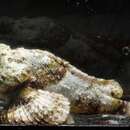Diagnostic Description
provided by Fishbase
A black spot nearly as large as eye on inner surface of pectoral fins near base of first 5 rays; no black mark inside mouth at front of upper jaw. Ascending process of premaxilla narrow, its maximum width 1.8-2.2 in orbit diameter; a series of papillae or nodules (sometimes on a low ridge) across interorbital space between supraocular spines; nasal spine single (Ref 42181).
- Recorder
- Cristina V. Garilao
Morphology
provided by Fishbase
Dorsal spines (total): 12; Dorsal soft rays (total): 9; Analspines: 3; Analsoft rays: 5
- Recorder
- Cristina V. Garilao
Trophic Strategy
provided by Fishbase
Sluggish carnivore which lurks beneath coral heads and ledges on both interisland reef shallows and the seaward reef. It lies motionless while waiting for fish and invertebrates to venture close enough to capture (Ref. 275).
Biology
provided by Fishbase
Usually found immobile at the bottom camouflaged among rocks and coral. Hunts by ambushing prey (Ref. 5503). Unlike most scorpaenids, the sting from the dorsal spines of this species can be painful but does not pose any real danger to the victim (Ref. 5503). Sold fresh in small quantities in markets.
Importance
provided by Fishbase
fisheries: minor commercial; price category: high; price reliability: very questionable: based on ex-vessel price for species in this family
Humpbacked scorpionfish
provided by wikipedia EN
The humpbacked scorpionfish (Scorpaenopsis gibbosa) is a species of venomous marine ray-finned fish belonging to the family Scorpaenidae, the scorpionfishes. This species is found in the western Indian Ocean.
Taxonomy
The humpbacked scorpionfish was first formally described as Scorpaena gibbosa by the German naturalists Marcus Elieser Bloch & Johann Gottlob Theaenus Schneider with the type locality given as with "America" erroneously given as the type locality of this Indian Ocean species.[3] In 1829 the French zoologist Georges Cuvier described Scorpaenopsis nesogallica as a new species with its type locality given as Mauritius. The genus Scorpaenopsis was created in 1840 by the Austrian zoologist Johann Jakob Heckel and in 1876 Pieter Bleeker designated Scorpaena nesogallica as the type species of Scorpaenopsis and S. nesogallica was later shown to be a junior synonym of S. gibbosa.[3][4] The specific name gibbosa means "humpbacked" (dorsa gibbo) a reference to the arced back of this species.[5]
Description
The humpbacked scorpionfish has a dorsal fin which contains 12 spines and 9 soft rays while the anal fin has 3 spines and 5 soft rays.[2] It also typically has 17 fin rays in its pectoral fin and an elevated back.[6] This species attain a maximum published standard length of 21 cm (8.3 in). There is black spot almost the same size as the eye on the inner surface of pectoral fins close to base of its first 5 fin rays.[2]
Distribution and habitat
The humpbacked scorpionfish is found in the western Indian Ocean. It occurs along the coast of eastern Africa from Kenya south to Mozambique and eastern South Africa and in the Indian Ocean off the Comoros, Madagascar, Mauritius, Réunion, Seychelles and as far east as the Chagos Islands. It has been collected down to depths of 15 m (49 ft),[1] it is a demersal species found among rocks and coral.[2]
Biology
The humpbacked scorpionfish is an ambush predator, waiting on the substrate using its excellent camouflage and striking when its prey comes within range. The spies in the dorsal fin have venom glands and they can deliver a very painful sting, but it is not usually dangerous.[2]
References
-
^ a b Motomura, H.; Matsuura, K. & Khan, M. (2016). "Scorpaenopsis gibbosa". IUCN Red List of Threatened Species. 2016: e.T69918902A70009975. doi:10.2305/IUCN.UK.2016-3.RLTS.T69918902A70009975.en. Retrieved 18 February 2022.
-
^ a b c d e Froese, Rainer; Pauly, Daniel (eds.) (2021). "Scorpaenopsis gibbosa" in FishBase. August 2021 version.
-
^ a b c Eschmeyer, William N.; Fricke, Ron & van der Laan, Richard (eds.). "Species in the genus Scorpaenopsis". Catalog of Fishes. California Academy of Sciences. Retrieved 18 February 2022.
-
^ Eschmeyer, William N.; Fricke, Ron & van der Laan, Richard (eds.). "Genera in the family Scorpaenidae". Catalog of Fishes. California Academy of Sciences. Retrieved 18 February 2022.
-
^ Christopher Scharpf & Kenneth J. Lazara, eds. (2 October 2021). "Order Perciformes (Part 9): Suborder Scorpaenoidei: Family Scorpaenidae". The ETYFish Project Fish Name Etymology Database. Christopher Scharpf and Kenneth J. Lazara. Retrieved 17 February 2022.
-
^ Eschmayer, W.N. & J.E. Randall (1975). "The scorpaenid fishes of the Hawaiian Islands, including new species and new records (Pisces: Scorpaenidae)". Proceedings of the California Academy of Sciences. Series 4. 40: 265–334.

- license
- cc-by-sa-3.0
- copyright
- Wikipedia authors and editors
Humpbacked scorpionfish: Brief Summary
provided by wikipedia EN
The humpbacked scorpionfish (Scorpaenopsis gibbosa) is a species of venomous marine ray-finned fish belonging to the family Scorpaenidae, the scorpionfishes. This species is found in the western Indian Ocean.
- license
- cc-by-sa-3.0
- copyright
- Wikipedia authors and editors
Description
provided by World Register of Marine Species
Usually found immobile at the bottom camouflaged among rocks and coral. Hunts by ambushing prey (Ref. 5503). Unlike most scorpaenids, the sting from the dorsal spines of this species can be painful but does not pose any real danger to the victim (Ref. 5503). Sold fresh in small quantities in markets.
Froese, R. & D. Pauly (Editors). (2023). FishBase. World Wide Web electronic publication. version (02/2023).
- license
- cc-by-4.0
- copyright
- WoRMS Editorial Board

